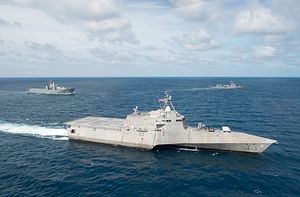At Lawfare, Peter Dutton and Isaac Kardon argue that the focus on Freedom of Navigation Operations (FONOPs) in the South China Sea has come to obscure the basic strategic issues, rather than illuminate them. Dutton and Kardon suggest that the U.S. government and the U.S. Navy ought to reconsider the use of FONOPs as a political tool, and instead concentrate on the broader goal of sailing whenever, and wherever, it feels itself legally entitled to sail.
Over the past weeks, the U.S. Navy and a considerable portion of the U.S. strategic analyst community have staked out the position that whether a U.S. destroyer conducts a “man overboard” drill in the vicinity of a Chinese installation has strategic relevance. The analytic community was previously gripped by the question of why the United States had conducted no FONOPs since the beginning of the Trump administration; before that, it pondered whether a FONOP without a “man overboard” drill constituted a sufficiently robust response to the growth of Chinese naval power and the assertiveness of China’s territorial claims in the South China Sea.
The notion of the utility of FONOPs is built around the idea that the Chinese are hypersensitive to U.S. messages regarding SCS installations, and that the Chinese will read such messages in the way that we intend; in other words, the Chinese are listening, and there is no meaningful noise to muddle what we’re saying. Of the first assumption there is considerable evidence; Chinese officials do seem to pay a great deal of attention to U.S. vessels when they conduct freedom of navigation missions in the South China Sea. Of the second, there is considerably less evidence.
At the very best, conveying critical strategic messages through military action is fraught with difficulty and contradiction. What does the action mean? How will the target interpret the action? Will the target believe the action represents a credible commitment, or cheap bluster? Literal bookshelves of foreign policy work has been produced on these questions, but have failed to resolve the basic conundrum; the messages we want to send are only rarely the messages that others hear.
FONOPs taken; FONOPs not taken; FONOPs misconducted; FONOPs conducted at the behest of one element of the U.S. foreign policy hierarchy rather than some other element; FONOPs as indicative of the policy of one administration rather than another. In sum, Dutton and Kardon make clear that FONOPs make nothing clear; they are inadequate to conveying precision-guided messages to the Chinese military and diplomatic establishment. FONOPs impose no practical constraints on China’s development of new installations in the SCS. They send no obvious message about conditions under which the United States might go to war. They are as likely to confuse potential allies as they are to confuse the Chinese.
The United States has taken on an enormously difficult task in the South China Sea. It needs to convince China that it cares as much about quasi-island-features in the South China Sea as China does, and that it is willing to take expensive risks in order to prevent China’s expansion of these features. Given that the U.S. has no territorial claims of its own, and that the U.S. has struggled to develop a compelling economic argument regarding the relevance of these features, it is proving extremely difficult for Washington to convince Beijing of its seriousness. FONOPs are the tool that the United States has happened upon, but they are altogether inadequate to the task.

































